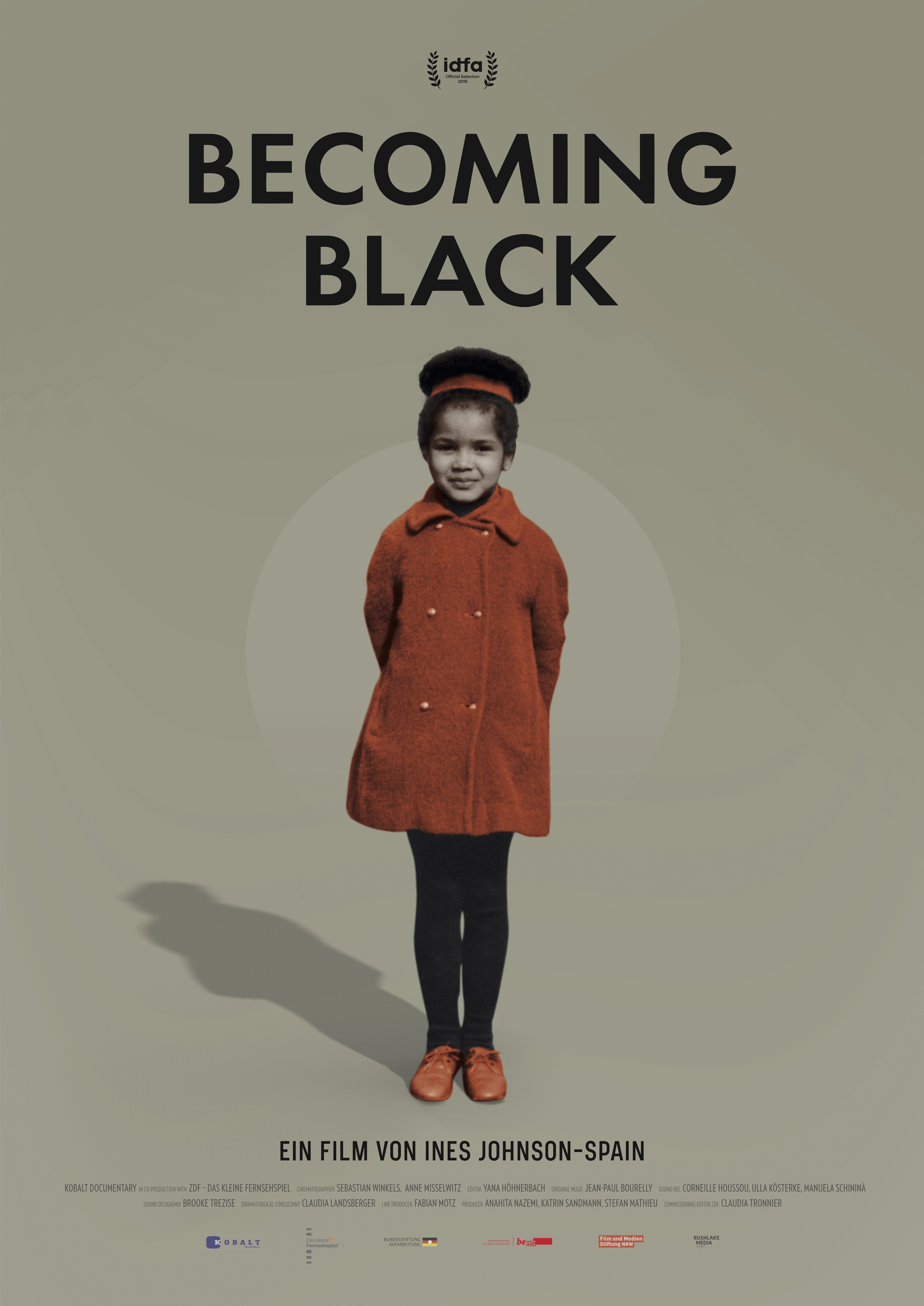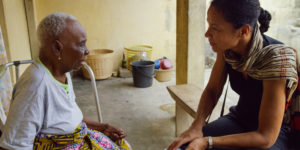Becoming Black
Ines Johnson-Spain (dir.), Becoming Black (2019), Film.
Becoming Black(Becoming Black, by independent filmmaker Ines Johnson-Spain, is a Kobalt Documentary production that premiered in 2019 at the International Documentary Film Festival Amsterdam. Since then, it has been screened at several international film festivals and received the 2020 Best Diaspora Documentary from the Africa Movie Academy.) opens with a picturesque view of waves crashing on the Togolese shore. Off-camera, the first-person narrator recalls being a ten-year-old girl in an East Berlin apartment with her mother, who recounts a story to her as if she is divulging a secret. It was her mother’s recollection of a chilly winter day in 1961 when the news of Pan-Africanist icon Patrice Lumumba’s assassination had spread from Lubumbashi to her university in Bernau, East Germany. The African students had slowly retreated from the building; they gathered closely in the frigid weather, embracing one another and mourning. The narrator’s mother, a white German woman, was so deeply moved that she cried with them. Close to fifty years later, her daughter remembers the intimacy of this moment in which she felt as if her mother, after recanting a moment of closeness with African students while in college, would finally explain why she, the narrator, had darker skin than the rest of her family. It would not be until years later that the daughter would truly understand the deep significance of the story as it pertains to her life.

Image Courtesy of Ines Johnson-Spain.
The documentary Becoming Black is a living memoir of the filmmaker herself, Ines Johnson-Spain. In this tale of metamorphosis, the titular focus is Johnson-Spain’s pursuit of developing an authentic understanding of who she is as a German/Togolese woman. Through excavating memories from her childhood, interviewing family members, and traveling between Togo and Germany, she captures the scenes of her own becoming. What distinguishes Johnson-Spain’s childhood from other Afro-German narratives is her white parents’ decision to pretend that her darker skin tone was merely genetic happenstance. Her biological father, Lucien Johnson from Togo, was part of a group of African men invited by the GDR government to attend Fritz-Heckert Trade Union College in Bernau during the early 1960s. This geopolitical connection between Africa and East Germany was a result of global Marxist-Leninist exchange and solidarities. However, the comradeship of African international students with white Germans was deeply fractured by racism and xenophobia. Although white women and African men were discouraged from social and romantic intimacies on campus, Johnson-Spain’s white German mother Sigrid had an affair with Lucien. Their relationship was scandalous because it was interracial, and Sigrid was married to Armin, with whom she already had a son. When Johnson-Spain was born in 1962, her mother placed her in a children’s home for a few years while she and her husband were separated because of her affair. Eventually choosing to mend their marriage for the sake of their son Michael, Sigrid and Armin adopted Johnson-Spain from the children’s home and ultimately raised her as their own without informing her that her biological father was Lucien from Togo. Although Sigrid died when Johnson-Spain was just twenty years old, the realities of their mother-daughter relationship were communicated through interviews with family and friends. For the first time, Johnson-Spain discussed her racial identity with her adoptive father, half-brother, and other white people with whom she was raised.

Image courtesy of Ines Johnson-Spain.
Viewing this film is deeply uncomfortable at times, as we witness a severe lack of awareness on the part of the white German adults who raised Johnson-Spain of the significance of race and belonging for Black children in white families. In a harrowing scene, Sigrid’s older brother, Michael, shares with Johnson-Spain that their mother once admitted to him that she loved him more. Michael has vivid memories of Sigrid neglecting Johnson-Spain and being upset by it; however, he, like the rest of their family and close friends, mostly chose to stay silent on the matter until prompted by Johnson-Spain during the research she conducted for the documentary. As children, she and her brother accidentally discovered a letter to her mother from the state, rejecting her request for an abortion and a paternity test proving that Lucien Johnson is her biological father. Johnson-Spain describes this as a surreal but ultimately formative experience for her, as she then searched for information about Togo in an encyclopedia, starting a lifelong journey of grappling with her African heritage, but chose not to tell her parents what she had discovered. Simultaneous with the confusion and discomfort at home, she was bullied extensively at school, as white German children sought to ridicule her for her complexion and hair type. Moments of this nature from her childhood in the 1960s still haunt Johnson-Spain’s sense of self as she situates herself as a Black German woman in the 2000s.

Image courtesy of Ines Johnson-Spain. Photograph by Kobalt Productions GmbH.
While the filmmaker maintains that the goal of Becoming Black is not to produce an essentialist contrast between racism in Germany and empowerment in Togo, the communal and affective differences between Johnson-Spain’s experiences in each country are apparent. Eight years after her mother’s death, at the age of twenty-eight, she travels to Togo for the first time. She is strolling around her hotel in Lomé when a group of young men ask her if she needs help finding where she is going. Not expecting an answer but willing to socialize, she tells them she is looking for her family. One of the young men runs into a nearby store and comes out with a newspaper, informing her that her uncle just passed away, and directing her to where her family lives. Very quickly, she finds one of her cousins who then introduces her to the Johnsons living in Togo. In a powerful moment, she receives her father’s phone number for where he is living in Germany, and calls him, stating that she is his daughter from East Germany, the child of Sigrid. From that point on, while still in Togo, Johnson-Spain meets her aunts, cousins, and uncles who expose her to the Togolese heritage she had been denied access to by her parents’ choice to keep her ancestry a secret from her. The documentary includes scenes from time she spent in Togo since 2012 when she began research and filming for Becoming Black. A few of the scenes there are shot in her father’s family’s living room, with portraits of the Johnson family all over the walls. Photographs of herself and of her father being placed on the wall become a symbol for her inclusion in that family. At this point, her father is deceased, and she maintains a connection to him through the spiritual practices of her family. In another scene, she is present as her auntie provides offerings to their ancestors, her father included, in a ritual setting. Another woman in her family translates the Ewe language for her, relaying that they are honoring and communicating with the realm of the ancestors. The transformation is striking: we meet Johnson-Spain through recollections of her childhood in the 1960s when she is bullied for being Black without an opportunity to be politically empowered by her cultural heritage. Now, she not only has access to living family and Togo as a physical home, but also a spiritual one.

Image courtesy of Ines Johnson-Spain. Photograph by Kobalt Productions GmbH.
Becoming Black is a non-linear representation of Johnson-Spain’s experiences. Her memories from the 60s and 70s GDR continuously affect her ongoing present, whether she is in Germany or Togo. Her decision to montage memories and moments through interviews, off-camera narrations, and history lessons — as opposed to a linear memoir—is a particularly Black European aesthetic choice. The storytelling practices of Black European women are a key problem-space for writer and scholar Fatima El-Tayeb.(Fatima El-Tayeb, European Others: Queering Ethnicity in Postnational Europe (University of Minnesota Press, 2011).) Black European women’s marginalization from dominant conceptualizations of Blackness or Europeanness is also an opportunity for alternative storytelling with experimental formal strategies. In her own work, Tayeb has turned to Tina Campt’s research on Black Germans in the Third Reich,(Tina Campt, Other Germans: Black Germans and the Politics of Race, Gender, and Memory in the Third Reich, (University of Michigan Press, 2004).) arguing that Afro-German collective consciousness is limited by a lack of transmission of diasporic memory across historic generations because most Black children in Germany were not raised by their Black parents. While this has changed since the twentieth century Afro-German political movement—its continuous influence evidenced by the publication of Showing Our Colors: Afro-German Women Speak Out in 1986 which has become a canonical text—the proliferation of Afro-German and Black European narratives is of much importance today. One can compare Ines-Johnson Spain to other filmmakers such as Belgium-based Cameroonian Rosine Mbakam and Afro-Germans Natasha A. Kelly and Mo Asumang, among others. Weaving non-linear narratives and engaging issues of erasure and European colorblind racism constitute the politics and aesthetics of much of recent Black European cinema that focuses on identity and collective consciousness.
A historical account of racism and invisibility during the 1960s GDR encourages us to engage the nuances of Black diasporic politics today. Johnson-Spain’s narrative reveals how institutionalized and interpersonal racism existed in East Germany despite government initiatives intended to build solidarity between the GDR and decolonized African countries. The tensions between the GDR’s purported anti-racist values and the everyday racism against Africans from the East German population are currently being explored by scholars such as Sara Pugach, whose book African Students in the German Democratic Republic, 1949- 1975 is set for publication in 2021. Through interviews with white German friends and family, Johnson-Spain, too, learns about protests by African college students in East Germany against state surveillance and racism. Their disruption of the hegemonic status quo differed vastly from the beliefs of the majority white East German population, which insisted on treating any open discussion of race as a taboo.
The film closes with new possibilities for building community. Johnson-Spain discovers that she has several siblings from her father Lucien. They meet in a grass field, sitting on a blanket, sharing old photographs of their mothers with one other. Their candid dialogue about topics such as how much they look like either of their parents, is warm and authentic. There is a feeling that perhaps home, for Johnson-Spain, is with her siblings. The existence of a childhood in which her parents could raise her with an awareness of her cultural heritage was impossible, but as an adult, she now has the option of continuing in relation with these siblings with whom she did not grow up.
In the finale scene, Johnson-Spain returns to the Togolese shore. This time she is in the frame, sitting on the sand. She appears at peace, deeply in thought, absorbing the beauty around her. Fishermen are working together, pulling nets and boats on the shore. Togolese children run by on the sand, excitedly shouting greetings to her and referring to her as “Yovo.” Yovo is generally translated as white person in Ewe. Her relationship to Togo, generative as it is in her pursuit of becoming, is not without its complications. Her lighter skinned, mixed race appearance and German accent make her stand out as a foreigner/white person despite her biological father being Togolese. Hence, we know that her visible comfort and peace with being on the Togolese shore, taking in the beauty, and maintaining connections with her family there does not mean she has reached a so-called authentic Togolese identity. Instead, she carries her upbringing and memories from her childhood in Germany with her to Togo. Her culture and sense of self bear the mark of both worlds – Germany and Togo — and she is emboldened by her access to traversing both, despite the inevitable feelings of (sometimes) being an outsider. The beginning and concluding scenes depicting the alluring Togolese shore appear to symbolize this traversal, and a sense of peace with the im/possibility of absolute belonging on either side of the Atlantic Ocean.
This article is part of the Special Issue Art and Race in Contemporary Central and Eastern Europe. You can find links to the other articles in the special issue below:





